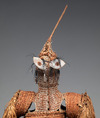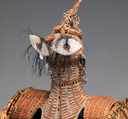Body Mask
Not on view
The Asmat people of southwest New Guinea create and use elaborate woven masks for ritual feasts that celebrate the passage of the recently deceased from the world of the living to the ancestral realm known as safan. Each body mask is a complex ensemble comprising a wealth of locally sourced materials including mulberry fiber, sago palm leaves, wood, bamboo, feathers and seeds. The torso and shoulders are constructed of rattan in a single rod coiled basketry technique. The fine fiber cord is then attached to the rattan waistband and the mask is gradually built up, using a delicate single element looping technique, to complete the chest and headpiece. The mask is then painted with red ochre and lime and the important appendages are added. The waistband and sleeves are adorned with lengths of sago palm leaves which form a rustling skirt and fringes which hang down over the arms. This particularly elaborate example has intricate and very finely executed fiber work in the striped cord bodice and head piece which is decorated with tassels comprising feathers and seeds, and topped off with a dramatic extension that reaches upwards. Dramatic wooden eye lozenges incorporated into the headpiece give the figure an imposing and lively character. These eye elements have been washed with a white lime and red ochre rim that highlights the black pupils and are embellished with black cassowary bird feathers.
This remarkable body mask is part of a collection of Asmat art made by Michael C. Rockefeller when he visited the Asmat region of New Guinea in 1961. He negotiated for it with clan leaders in the village of Pupis on the northern tributary of the Upper Pomatsj River. It is one of a set of seven that were made on the occasion of the construction of a new feast house in the village. In Asmat cosmology, when an individual dies their spirit (ndat) typically enters a state of limbo, a threshold between the human world and the ancestral realm safan. A restless spirit lingering near the community has the potential to cause misfortune or illness, so it is customary for its living relations to host a feast ceremony (jipae) that will assist the spirit in moving onward to the next stage of its journey. The precise details of these rites vary from place to place but in general all Asmat mask feasts share a common goal – to welcome the spirits of the dead briefly back to the community for a feast and celebration, after which the spirits are expected to permanently leave the world of the living. This serves as a way of restoring harmony to the community.
Every few years, after several people have died within a village, the male elders gather and decide to hold a mask feast. Masks are prepared in secret within the confines of the men’s ceremonial house (yeu) and can take up to four to five months to complete. The maker of the body mask is hosted by the sponsor who accommodates him with food and drink while the mask is begin prepared. When all masks have been readied, the feast ceremony (jipae) can begin.
Great importance is attached to the role of the mask wearer – not only does he play the part of the deceased, he also takes on the dead person’s responsibilities including the care of any children now orphaned as a result of his demise. The climax of the ceremonies involves the emergence of the masks from the forest that surrounds the village. The first to emerge is a conical basketry mask, which in some areas represents Mbanma, an orphan of legendary status who appears as a comic prelude. He capers about humorously whilst being pelted by the children with palm leaves and husks. The next day he accompanies the formal arrival of the dead, a group of elaborately woven fiber masks such as this one, who emerge from the forest at the edge of the village. Each mask represents a specific ancestor whose name it bears and is typically worn by a close relative of deceased. The group of masks can number between six and twenty in a single feast ceremony. They are fondly greeted by their relatives and tour the village where they are presented with food and hospitality. They proceed eventually to the men’s house (yeu) where all dance together, the living and the dead mingling in a lively engagement which continues into the night. The following morning the dead, their spirits (appeased by the feast and entertainment they have received, or frightened at the prospect of challenges that will be made to them if they do not move on) disappear into the forest to make their journey onwards to safan where they will be transformed into ancestral beings. At the conclusion of the dance rites, the costumes are disassembled. Leaf skirts and fringes are burned but the fiber body masks, now imbued with the power of the ancestors, are often kept in the men’s ceremonial house and can be reused in future ceremonies. They may also be placed at the base of a banyan tree or sago palm where they slowly decay, their fertile powers working their way into the forest undergrowth to invigorate the growth of the next generation of sacred trees.
Maia Nuku, 2020
Evelyn A. J. Hall and John A. Friede Associate Curator Oceanic Art
Published
Rockefeller, Michael Clark, and Adrian A. Gerbrands. The Asmat of New Guinea. The Journal of Michael Clark Rockefeller, with his Ethnographic Notes and Photos Made among the Asmat People during Two Expeditions in 1961, Documented by a Pictorial and Descriptive Catalogue of the Objects He Collected. Edited by A.A. Gebrands. New York: Museum of Primitive Art, 1967
Bayer, Andrea, with Laura D. Corey (eds). Making the Met, 1870-2020. New York : The Metropolitan Museum of Art, 2020
Due to rights restrictions, this image cannot be enlarged, viewed at full screen, or downloaded.
This artwork is meant to be viewed from right to left. Scroll left to view more.











